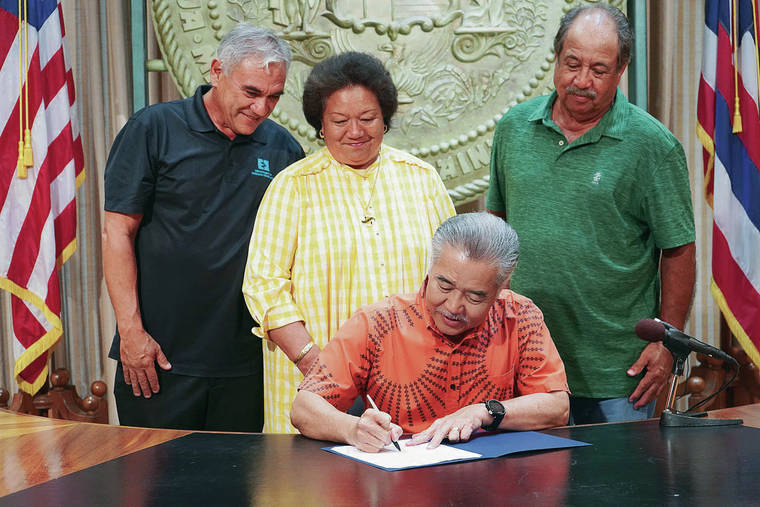Gov. David Ige on Monday signed new administrative rules that allow the Department of Hawaiian Home Lands to develop multifamily, rental and
kupuna housing on trust property,
providing a new tool that Ige and the state agency say eventually will help address a huge backlog of Native
Hawaiians waiting for homestead leases.
A previously announced project of affordable rentals planned in Moiliili is expected to be the first one developed under the new rules.
The department, which manages a 203,000-acre land trust for those who are at least 50% Native Hawaiian, historically has focused on developing lots to meet the demand for residential, farming and ranching homesteads.
DHHL offered many of the lots with homes ready to be occupied, while
others had the infrastructure but no homes, giving beneficiaries the opportunity to build their own or hire their own contractors.
In all cases, beneficiaries pay $1 per year for the 99-year land leases.
But with more than 28,000 beneficiaries on a waitlist, many of whom cannot qualify for mortgages that typically run in the high $200,000s to high $300,000s, there have been calls to broaden the affordable housing choices offered by the department.
The new set of rules “really expands the options for beneficiaries on Hawaiian homesteads,” Ige said at a news conference during which he formally approved the regulations.
“These rules are an excellent tool in our tool chest,” added William Aila, department director and chairman of the Hawaiian Homes Commission, which oversees the agency.
Because of the mortgage hurdles for the housing options DHHL currently offers, the rental program would provide an affordable alternative that will give beneficiaries an opportunity to save money and better position themselves to qualify for a homestead when a lease eventually is offered, according to Ige and Aila.
With Ige’s support, Aila said the department will
be looking to partner with other Hawaiian entities that have expressed a willingness to establish more
housing for the elderly,
or kupuna.
Some of that rental
housing would be filled
by kupuna with homestead leases, and their homesteads in turn can be offered to other beneficiaries, according to Aila.
“It helps to ease people off the waitlist,” he added.
The new rules, the culmination of a nearly two-year process that included consulting with beneficiaries statewide, drew mixed reaction Monday.
“It helps,” said Blossom Feiteira, Maui president of the Association of Hawaiians for Homestead Lands. “I think it’s great that we’ll be able to put more people on the land faster.”
But Robin Danner, chairwoman of the Sovereign Councils of the Hawaiian Homelands Assembly, didn’t share such optimism.
“These rules set up the same bureaucracy, the same political patronage that DHHL has fed off of for 6 decades,” Danner wrote in a text message. “I’m sorry to be the one to say, on behalf of SCHHA, that these rules are a false hope, an empty promise, that will lead to the same dead-end canyon of a poorly run state agency, trying to be all things. Just be one thing. Issue land, issue lots to Hawaiians. For homes. For ranches. For farms. For mercantile business. Do that well. We will do the rest.”
DHHL recently awarded nearly 300 homestead lots, has another 394 to issue soon and is on track to develop about 1,300 over the next five years, according to Aila.
At Ige’s urging, the agency is looking for creative ways to develop more housing to pare the waitlist, he added.
Aila cited an example of
a Waimanalo home that
recently was completed with the help of Habilitat
for Humanity, a nonprofit housing organization.
The beneficiary family was able to move into a six-bedroom, three-bathroom multigenerational home with a monthly mortgage payment of $1,100 a month — less than the $1,800 the family had been paying for years to rent
a two-bedroom, two-
bathroom home, according to Aila.
He also said the department expects to announce soon a Maui project for which it will use affordable housing credits, working with a developer to produce 137 ready-to-occupy homes and 23 vacant lots.
Ige said the state is examining all affordable housing projects to see if a beneficiary component can be
incorporated.
“If there’s a way we can have Hawaiian homestead participation, that’s what we would like to see,” he added.
The proposed Moiliili project wouldn’t be the first rental housing on trust land. A Maili development for transitional housing and
a Waimanalo complex for
kupuna were built years ago, but those weren’t exclusively for beneficiaries, largely because some funding sources prohibited such practices.
The Maili development served all homeless and the Waimanalo one served all Hawaiians, not just those who were at least half
Hawaiian.
The Maili project has since closed, and DHHL is soliciting proposals to convert that complex to rental housing for beneficiaries — another project that would be developed under the new rules.

